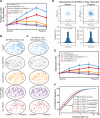Single-molecule dynamics of the P granule scaffold MEG-3 in the Caenorhabditis elegans zygote
- PMID: 30540524
- PMCID: PMC6589573
- DOI: 10.1091/mbc.E18-06-0402
Single-molecule dynamics of the P granule scaffold MEG-3 in the Caenorhabditis elegans zygote
Abstract
During the asymmetric division of the Caenorhabditis elegans zygote, germ (P) granules are disassembled in the anterior cytoplasm and stabilized/assembled in the posterior cytoplasm, leading to their inheritance by the germline daughter cell. P granule segregation depends on MEG (maternal-effect germline defective)-3 and MEG-4, which are enriched in P granules and in the posterior cytoplasm surrounding P granules. Here we use single-molecule imaging and tracking to characterize the reaction/diffusion mechanisms that result in MEG-3::Halo segregation. We find that the anteriorly enriched RNA-binding proteins MEX (muscle excess)-5 and MEX-6 suppress the retention of MEG-3 in the anterior cytoplasm, leading to MEG-3 enrichment in the posterior. We provide evidence that MEX-5/6 may work in conjunction with PLK-1 kinase to suppress MEG-3 retention in the anterior. Surprisingly, we find that the retention of MEG-3::Halo in the posterior cytoplasm surrounding P granules does not appear to contribute significantly to the maintenance of P granule asymmetry. Rather, our findings suggest that the formation of the MEG-3 concentration gradient and the segregation of P granules are two parallel manifestations of MEG-3's response to upstream polarity cues.
Figures






References
-
- Alberti S, Carra S. (2018). Quality control of membraneless organelles. J Mol Biol , 4711–4729. - PubMed
Publication types
MeSH terms
Substances
Grants and funding
LinkOut - more resources
Full Text Sources
Other Literature Sources
Miscellaneous

